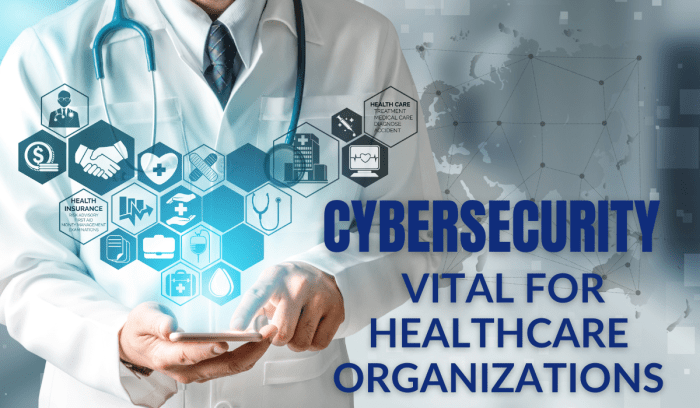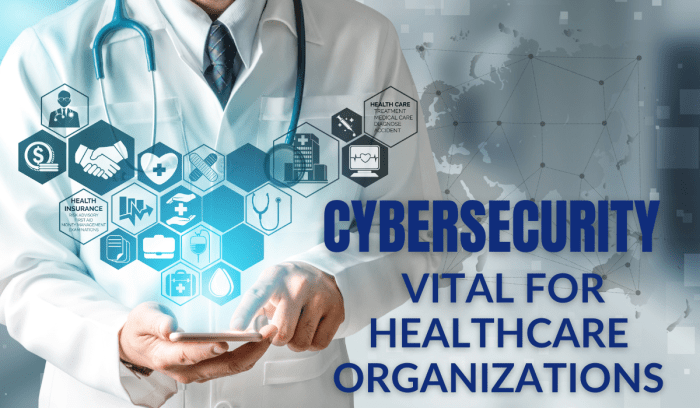Healthcare experiences cybersecurity emergencies are a growing concern, and this article explores the intricate landscape of risks, impacts, and responses. From the vulnerabilities in electronic health records (EHR) systems to the devastating consequences of data breaches, we’ll examine the challenges faced by healthcare organizations in navigating these critical situations.
This in-depth analysis will cover various aspects, including the different types of cyberattacks targeting healthcare, their potential impact on patient care and operations, the development of emergency response plans, improving cybersecurity practices, and understanding legal and regulatory compliance. We’ll delve into the details of these topics, providing practical insights and actionable strategies for safeguarding patient data and ensuring the continuity of care.
Understanding Healthcare Cybersecurity Risks
Protecting sensitive patient data is paramount in healthcare. Cybersecurity threats are constantly evolving, posing significant risks to the confidentiality, integrity, and availability of electronic health records (EHRs). This necessitates a proactive and comprehensive approach to risk management. Healthcare organizations must understand the potential vulnerabilities and impacts to effectively safeguard patient information.
Common Cybersecurity Threats Targeting Healthcare Organizations
Healthcare organizations face a multitude of cyber threats, each with the potential to cause substantial harm. These threats exploit vulnerabilities in systems and networks, often targeting sensitive patient data. Malicious actors employ various techniques to gain unauthorized access, disrupt operations, or extort money. The consequences can range from financial losses to severe reputational damage and even harm to patients.
Vulnerabilities within Electronic Health Records (EHR) Systems
EHR systems, while crucial for modern healthcare, often present specific vulnerabilities. These systems store vast amounts of sensitive patient data, making them prime targets for cybercriminals. Weaknesses in authentication protocols, inadequate security patches, and lack of multi-factor authentication create entry points for attackers. Poorly configured systems, inadequate data encryption, and insufficient access controls further contribute to these vulnerabilities.
The interconnected nature of EHR systems can also create cascading effects, where a breach in one system can compromise others.
Potential Impact of Data Breaches on Patient Privacy and Confidentiality
Data breaches in healthcare have far-reaching consequences, significantly impacting patient privacy and confidentiality. Stolen patient information can be used for identity theft, fraud, or even blackmail. Patients may experience emotional distress, financial hardship, and a loss of trust in the healthcare system. The reputational damage to healthcare organizations following a breach can be substantial, affecting their ability to attract and retain patients.
Furthermore, regulatory penalties, legal actions, and significant financial losses are potential outcomes.
Examples of Past Healthcare Cybersecurity Emergencies and Their Consequences
Numerous past cybersecurity incidents have underscored the critical need for robust security measures. The WannaCry ransomware attack in 2017 crippled healthcare systems globally, disrupting critical operations and impacting patient care. Similar incidents highlight the potential for widespread disruption and the devastating impact on patient safety.
Different Types of Cyberattacks Targeting Healthcare and Their Potential Impact
Understanding the diverse types of cyberattacks targeting healthcare is crucial for implementing effective mitigation strategies. This table Artikels common attack types, their descriptions, potential impacts, and mitigation strategies.
| Attack Type | Description | Potential Impact | Mitigation Strategies |
|---|---|---|---|
| Phishing | Deceptive emails or messages attempting to trick users into revealing sensitive information (passwords, usernames, etc.). | Unauthorized access to accounts, compromise of sensitive data, financial losses, and reputational damage. | Employee training on recognizing phishing attempts, strong authentication measures, and email filtering. |
| Malware | Malicious software designed to damage, disrupt, or gain unauthorized access to systems. | Data breaches, system downtime, data corruption, and financial losses. | Regular software updates, robust anti-malware protection, and secure network configurations. |
| Ransomware | Malicious software that encrypts data and demands a ransom for its release. | Data loss, business disruption, financial losses, and potential harm to patient care. | Regular data backups, offline storage of backups, and robust incident response plans. |
Impact on Patient Care and Operations: Healthcare Experiences Cybersecurity Emergencies
Healthcare cybersecurity emergencies inflict significant disruptions, impacting both patient care and operational efficiency. These crises can range from minor inconveniences to catastrophic events, severely compromising the ability of facilities to provide essential services. Understanding the potential ramifications is crucial for proactive risk mitigation and preparedness.Cybersecurity incidents often lead to a cascade of negative consequences, hindering the smooth flow of patient care and operational processes.
This disruption can have profound implications for patient well-being and the overall effectiveness of healthcare facilities. The following sections detail the various ways these emergencies affect patient care and operational processes.
Disruption of Patient Care Workflows
Healthcare workflows are meticulously designed to ensure smooth and efficient patient care. These procedures rely heavily on uninterrupted access to electronic health records (EHRs), appointment scheduling systems, and communication platforms. Cybersecurity emergencies can quickly disrupt these processes, leading to delays in diagnosis, treatment, and patient follow-up. For example, a ransomware attack that locks down EHR systems could prevent doctors from accessing patient histories, potentially delaying critical diagnoses and treatments.
This disruption could have severe consequences, particularly for patients with complex medical needs or those requiring immediate attention.
Consequences of System Downtime on Patient Access
System downtime due to cybersecurity emergencies can severely limit patient access to critical services. This includes difficulties scheduling appointments, accessing test results, and receiving necessary medications. Consider the case of a hospital experiencing a system outage during a surge in emergency cases. The inability to access patient information and efficiently manage resources can significantly compromise patient care and safety.
In such situations, alternative solutions, like paper-based systems, may be insufficient to maintain the standard of care, and the consequences could be dire.
Healthcare experiences during cybersecurity emergencies can be quite stressful, right? Thinking about how vital medical data is, it’s clear that robust security measures are paramount. Luckily, distractions like a new TV can be a welcome diversion! If you’re looking for a new smart TV, checking out the tcl 6 5 series google tv price specs might be a good idea.
Regardless of your entertainment choices, the need for strong cybersecurity in healthcare settings remains crucial.
Impact of Data Breaches on Patient Trust
Data breaches, unfortunately, erode patient trust and confidence in healthcare facilities. The fear of having sensitive personal information compromised can lead to reluctance in seeking care. Patients may worry about the security of their medical records, impacting their willingness to engage with the healthcare system. This can lead to a decrease in patient volume, making it challenging for facilities to meet their operational targets.
A well-publicized data breach can severely damage a hospital’s reputation and patient loyalty, potentially affecting future revenue and attracting negative media attention.
Operational Challenges Faced by Healthcare Facilities
Healthcare facilities face numerous operational challenges during cybersecurity emergencies. These challenges include the need to restore critical systems, ensure business continuity, and maintain regulatory compliance. For example, the need to quickly restore EHR systems while adhering to data privacy regulations can be a complex and time-consuming process. Additionally, facilities may experience significant financial losses due to downtime, legal liabilities, and reputational damage.
The operational disruption often requires significant resources and expertise to manage effectively.
Comparison of Impact Across Different Cybersecurity Emergencies
| Emergency Type | Impact on Patient Care | Impact on Operations |
|---|---|---|
| Data Breach | Compromised patient confidentiality, potential for identity theft, decreased patient trust, delays in accessing medical records. | Significant legal and reputational risks, need for forensic investigation, potential for financial penalties, increased security protocols. |
| Ransomware Attack | Inability to access patient records, delays in diagnosis and treatment, disruption of critical services, potential for harm to patients. | Significant downtime, disruption of operational workflows, potential financial losses from ransom payments, need for system restoration. |
| System Outage | Delays in appointment scheduling, inability to access patient information, disruption of treatment protocols, difficulty in managing emergency cases. | Loss of productivity, inability to perform critical tasks, difficulty in maintaining business continuity, potential for financial losses. |
Developing Emergency Response Plans

Protecting patient care and operational integrity in healthcare requires a proactive and well-defined approach to cybersecurity emergencies. Effective emergency response plans are crucial for mitigating the impact of incidents, minimizing downtime, and ensuring business continuity. A robust plan encompasses various stages, from prevention to recovery, and empowers healthcare organizations to respond swiftly and effectively to threats.
Incident Response Framework
A comprehensive incident response framework for healthcare is a multi-layered approach designed to identify, contain, eradicate, and recover from cybersecurity incidents. It necessitates a dedicated incident response team with defined roles and responsibilities, a clear communication strategy, and established procedures for handling different types of incidents. The framework should be regularly reviewed and updated to adapt to evolving threats and vulnerabilities.
Healthcare experiences can be deeply affected by cybersecurity emergencies, often requiring rapid response. A faster, more intuitive way to find information during these critical moments could be incredibly helpful. For example, using a keyboard like swiftkey android keyboard search bing for quick access to reliable resources could improve efficiency in healthcare cybersecurity response. Ultimately, a streamlined approach to accessing crucial data during these emergencies is essential for healthcare providers.
Key Steps in a Cybersecurity Emergency Response Plan
A robust cybersecurity emergency response plan necessitates a structured approach. This involves several key steps: immediate containment of the incident to prevent further damage; a thorough investigation to determine the scope and cause of the breach; remediation of the affected systems and data; and finally, recovery of operations to pre-incident levels.
Proactive Measures to Prevent Future Attacks
Proactive measures are crucial in mitigating the risk of future attacks. These measures include regular security assessments, vulnerability scanning, and penetration testing to identify potential weaknesses in systems. Staff training programs to educate healthcare professionals on recognizing and reporting suspicious activities are also vital components. Furthermore, implementing strong access controls and multi-factor authentication adds another layer of protection against unauthorized access.
Ransomware Attack Response Flowchart
A ransomware attack requires a swift and coordinated response. The flowchart below Artikels the key steps:
- Detection: Identifying the ransomware attack.
- Containment: Isolating the affected systems to prevent further spread.
- Assessment: Determining the extent of the damage and the specific ransomware type.
- Decision: Deciding whether to pay the ransom or pursue alternative recovery methods.
- Eradication: Removing the ransomware and restoring systems to a clean state.
- Recovery: Recovering data and operations to pre-incident levels.
- Post-Incident Analysis: Evaluating the incident response process and identifying areas for improvement.
Business Continuity Strategies
During a cybersecurity emergency, maintaining business continuity is critical. Strategies for business continuity include having backup systems and data, disaster recovery plans, and establishing alternative communication channels. These strategies aim to minimize disruptions and ensure the continuation of patient care and operational functions.
Roles and Responsibilities During a Cybersecurity Emergency
A well-defined structure of roles and responsibilities is essential for effective incident response. This table Artikels the key roles and their respective responsibilities during a cybersecurity emergency.
| Role | Responsibilities | Contact Information |
|---|---|---|
| Incident Response Team Lead | Oversees the incident response process, coordinates team activities, and ensures adherence to the plan. | (e.g., Email address, phone number) |
| IT Security Officer | Identifies and assesses the impact of the incident, implements containment measures, and coordinates with external stakeholders. | (e.g., Email address, phone number) |
| Security Analyst | Investigates the cause of the incident, identifies affected systems, and develops remediation strategies. | (e.g., Email address, phone number) |
| Patient Care Coordinator | Ensures continuity of patient care, manages alternative communication channels, and implements contingency plans for patient access. | (e.g., Email address, phone number) |
Improving Cybersecurity Practices
Protecting patient data and operational stability in healthcare requires a multi-faceted approach to cybersecurity. Robust infrastructure, comprehensive employee training, and strong access controls are crucial for mitigating risks and maintaining trust. Effective data encryption and backup strategies provide essential safeguards against data breaches and operational disruptions. This section details key elements of a robust cybersecurity program.
Thinking about the scary reality of cybersecurity emergencies in healthcare, it’s easy to get caught up in the worry. Imagine the disruption to patient care if vital systems went down. Similarly, recent Xbox Live outages affecting multiplayer features like joining parties highlight the fragility of online services. Xbox Live outage down multiplayer join parties are a frustrating reminder that these services, much like healthcare systems, are vulnerable to unexpected problems.
Ultimately, both healthcare and gaming experiences are susceptible to disruptions when digital infrastructure fails, underscoring the need for robust security measures across the board.
Key Elements of Robust Cybersecurity Infrastructure
A robust cybersecurity infrastructure in healthcare goes beyond basic software. It encompasses a layered approach involving multiple security controls to protect sensitive data and systems. This layered approach includes hardware and software solutions, policies, and procedures, all working together to prevent unauthorized access and maintain system integrity. A well-designed infrastructure involves continuous monitoring and evaluation to ensure the security posture remains effective against emerging threats.
- Network Segmentation: Isolating critical systems and data on separate networks limits the impact of a breach. This strategy helps contain the damage if one part of the network is compromised.
- Firewall Implementation: A robust firewall controls network traffic, blocking unauthorized access while allowing legitimate communication. This involves configuring firewalls to filter specific types of traffic based on criteria such as IP addresses, ports, and protocols.
- Intrusion Detection and Prevention Systems (IDS/IPS): These systems continuously monitor network traffic for malicious activity. IDS/IPS systems identify and block suspicious patterns, effectively preventing attacks before they cause significant harm. IDS/IPS systems are crucial for real-time threat detection and response.
- Security Information and Event Management (SIEM) Systems: SIEM systems collect and analyze security logs from various sources. This analysis aids in identifying trends and patterns that might indicate potential threats.
Importance of Employee Training and Awareness Programs
Employee training and awareness are critical components of a comprehensive cybersecurity strategy. Human error is a significant factor in many security breaches, and training programs equip employees with the knowledge and skills to recognize and avoid these risks. Regular training sessions are essential to keep employees updated on the latest threats and best practices.
- Phishing Awareness Training: Employees need to be educated on how to identify phishing emails, links, and messages to prevent falling victim to social engineering attacks.
- Data Handling Procedures: Clear guidelines on how to handle sensitive patient data, such as encrypting data in transit and at rest, are essential.
- Password Management Practices: Strong passwords, multi-factor authentication, and regular password changes are essential to protect accounts and data.
- Reporting Procedures: Establishing clear channels for reporting suspected security incidents is vital. Employees must understand what to do if they encounter suspicious activity or potential security threats.
Need for Strong Access Controls and Authentication Methods
Strong access controls and authentication methods are essential for restricting access to sensitive data and systems. These controls determine who can access specific resources and how they can access them. Multi-factor authentication (MFA) adds another layer of security, making it more difficult for unauthorized individuals to gain access to accounts.
- Principle of Least Privilege: Users should only have access to the data and systems necessary to perform their job functions. Limiting access minimizes the potential damage if an account is compromised.
- Multi-Factor Authentication (MFA): This involves requiring multiple forms of verification, such as passwords, security tokens, or biometrics, before granting access to sensitive information.
- Regular Access Reviews: Periodically reviewing user access privileges ensures that access rights remain aligned with current job requirements. This helps to prevent unnecessary access or stale access to data.
Effective Data Encryption and Backup Strategies
Data encryption and robust backup strategies are essential to protect sensitive data from unauthorized access and loss. Data encryption renders data unreadable to unauthorized individuals, even if they gain access to the storage system. Regular backups ensure that data can be restored in the event of a data breach or system failure.
- Data Encryption: Encrypting sensitive data both in transit and at rest is crucial to protect confidentiality. Encryption makes data unreadable to unauthorized individuals.
- Regular Backups: Creating regular backups of data on separate storage systems is vital to ensure data recovery in case of a system failure or cyberattack.
- Data Recovery Planning: Having a well-defined data recovery plan ensures that data can be restored quickly and efficiently in the event of a disaster.
Examples of Successful Cybersecurity Implementations in Healthcare Settings
Numerous healthcare organizations have successfully implemented cybersecurity measures to protect patient data and operational stability. These implementations demonstrate the value of a proactive approach to cybersecurity.
- Hospital X: Implemented a comprehensive cybersecurity program that included employee training, network segmentation, and robust access controls. This proactive approach helped to prevent a significant data breach that could have occurred.
Comparison of Cybersecurity Solutions
| Solution | Description | Advantages | Disadvantages |
|---|---|---|---|
| Intrusion Detection System | Monitors network traffic for malicious activity | Early threat detection, real-time alerts | False positives, potential for alert fatigue |
| Firewall | Controls network traffic, blocking unauthorized access | Basic security, cost-effective | Requires configuration, limited advanced threat protection |
| Antivirus Software | Scans for and removes malware | Protection against known viruses and threats | Limited protection against zero-day exploits, requires updates |
| Multi-Factor Authentication (MFA) | Requires multiple forms of verification | Enhanced security, reduces risk of account compromise | Requires user adoption, can be inconvenient |
Legal and Regulatory Compliance
Navigating the complex world of healthcare cybersecurity requires a deep understanding of the legal and regulatory frameworks that govern sensitive patient data. These regulations are crucial for maintaining patient trust and ensuring the responsible handling of confidential information. Failure to comply can lead to severe consequences, including hefty fines and reputational damage. This section will delve into the specifics of these requirements, highlighting the importance of HIPAA compliance, penalties for non-compliance, incident reporting processes, and the roles of governing bodies in safeguarding patient data.
HIPAA Compliance in Healthcare
HIPAA (Health Insurance Portability and Accountability Act of 1996) is a cornerstone of healthcare data security. It establishes national standards to protect sensitive patient health information (PHI). These standards encompass various aspects, including access controls, encryption, and secure data transmission. Adherence to HIPAA regulations is paramount for healthcare organizations to maintain patient trust and avoid legal ramifications.
Failure to meet HIPAA standards can lead to substantial financial penalties.
Penalties for Non-Compliance
Non-compliance with healthcare cybersecurity regulations can result in severe penalties. These penalties can vary based on the nature and severity of the violation. Examples include substantial financial penalties, civil lawsuits, and criminal charges. The financial penalties alone can be crippling for smaller healthcare organizations. The potential for reputation damage and loss of patient trust are equally significant consequences.
Reporting Cybersecurity Incidents to Regulatory Bodies
Healthcare organizations must have established procedures for reporting cybersecurity incidents to the appropriate regulatory bodies. This process typically involves immediate notification of the breach, detailed documentation, and collaboration with law enforcement and regulatory agencies. Prompt reporting can help minimize the impact of the incident and facilitate a swift recovery. The process of reporting often requires a specific format and timeline, making pre-planning essential.
Roles of Governing Bodies in Cybersecurity Incidents, Healthcare experiences cybersecurity emergencies
Governing bodies, including the Office for Civil Rights (OCR) within the Department of Health and Human Services (HHS), play a crucial role in responding to cybersecurity incidents. They conduct investigations, provide guidance, and impose penalties for non-compliance. Their oversight ensures that healthcare organizations adhere to established standards and maintain the security of patient data. Their involvement often leads to significant improvements in overall cybersecurity practices within the healthcare industry.
Key Regulations Impacting Healthcare Cybersecurity
| Regulation | Description | Key Requirements |
|---|---|---|
| HIPAA | The Health Insurance Portability and Accountability Act of 1996 | Protects sensitive patient health information (PHI); mandates security standards for electronic PHI; establishes procedures for breach notification. |
| NIST Cybersecurity Framework | A voluntary framework developed by the National Institute of Standards and Technology (NIST) | Provides a structured approach to managing cybersecurity risks; offers guidelines for developing and implementing security controls. |
| State Laws | Various state laws may impose additional requirements for healthcare organizations | Often include specific provisions regarding breach notification, data security, and patient privacy; some states have stricter requirements than HIPAA. |
The table above summarizes key regulations impacting healthcare cybersecurity. Understanding the specifics of each regulation is vital for compliance and protecting sensitive patient data. Failure to comply with these regulations can lead to significant consequences for healthcare organizations.
Ultimate Conclusion

In conclusion, navigating healthcare cybersecurity emergencies requires a multi-faceted approach. Understanding the risks, planning for emergencies, and implementing robust cybersecurity practices are crucial for protecting patient data, maintaining operational continuity, and preserving trust. By proactively addressing these challenges, healthcare organizations can better safeguard their operations and uphold the highest standards of patient care.






